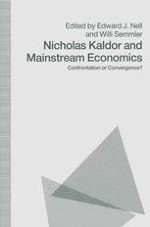1991 | OriginalPaper | Buchkapitel
Kaldor Between Hayek and Keynes, or: Did Nicky Kill Capital Theory?
verfasst von : M. Desai
Erschienen in: Nicholas Kaldor and Mainstream Economics
Verlag: Palgrave Macmillan UK
Enthalten in: Professional Book Archive
Aktivieren Sie unsere intelligente Suche, um passende Fachinhalte oder Patente zu finden.
Wählen Sie Textabschnitte aus um mit Künstlicher Intelligenz passenden Patente zu finden. powered by
Markieren Sie Textabschnitte, um KI-gestützt weitere passende Inhalte zu finden. powered by
Kaldor is famous as a leading member of that great generation of Cambridge economists — Joan Robinson, Piero Sraffa, Richard Kahn and himself — who together attempted the construction of an alternative paradigm to the neo-Classical/neo-Keynesian synthesis. For Joan Robinson and Richard Kahn, the engagement with Keynes’ economics was a continuous one and indeed part of the permanent revolution in economic thinking going on in Cambridge in the 1920s. Piero Sraffa started one phase of that revolution — the one in value theory — but his commitment to the Keynesian revolution was very slight. Indeed one could say that the two Cambridge revolutions, one started by Sraffa in 1926 and the other by Keynes in 1936 (although known earlier in Cambridge), were in contradiction with each other by the 1960s. The second Sraffa revolution begun in 1960 was a fulfilment of the one previously launched in 1926 but it had a value and capital theory that sat uncomfortably with the Keynesian revolution. Despite his intimate acquaintance with and encouragement of Sraffa’s work, Keynes in his General Theory took in his value theory a pre-Sraffa Marshallian line as far as he took any. Joan Robinson who with her exceptional rigour had worked out the consequences of the first two revolutions, Sraffa 1926 and Keynes 1936, bore the brunt of reconciling the second Sraffa revolution with the Keynesian revolution (See essays in Eatwell and Milgate, 1983).
